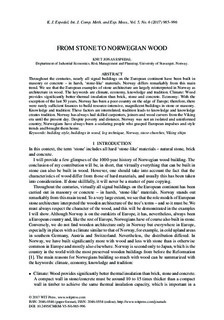| dc.contributor.author | Espedal, Knut Jonas | |
| dc.coverage.spatial | Norway | nb_NO |
| dc.date.accessioned | 2017-11-22T09:56:04Z | |
| dc.date.available | 2017-11-22T09:56:04Z | |
| dc.date.created | 2017-11-02T10:44:17Z | |
| dc.date.issued | 2017 | |
| dc.identifier.citation | Espedal, K. J. (2017) From Stone to Norwegian Wood. International Journal of Computational Methods & Experimental Measurements. 2017, 5 (6), 985-996. | nb_NO |
| dc.identifier.issn | 2046-0546 | |
| dc.identifier.uri | http://hdl.handle.net/11250/2467511 | |
| dc.description.abstract | Throughout the centuries, nearly all signal buildings on the European continent have been built in masonry or concrete – in harsh, ‘stone-like’ materials. Norway differs remarkably from this main trend. We see that the European examples of stone architecture are largely reinterpreted in Norway as architecture in wood. The keywords are climate, economy, knowledge and tradition. Climate: Wood provides significantly better thermal insulation than brick, stone and concrete. Economy: With the exception of the last 50 years, Norway has been a poor country on the edge of Europe; therefore, there were rarely sufficient finances to build resource-intensive, magnificent buildings in stone or masonry. Knowledge and tradition: These factors are interrelated; tradition leads to knowledge and knowledge creates tradition. Norway has always had skilled carpenters, joiners and wood carvers from the Viking era until the present day. Despite poverty and distance, Norway was not an isolated and uninformed country; Norwegians have always been a seafaring people who grasped European impulses and style trends and brought them home. | nb_NO |
| dc.language.iso | eng | nb_NO |
| dc.publisher | WIT Press | nb_NO |
| dc.subject | building style | nb_NO |
| dc.subject | wood buildings | nb_NO |
| dc.subject | log technique | nb_NO |
| dc.subject | stave churches | nb_NO |
| dc.subject | stavkirker | nb_NO |
| dc.subject | byggestil | nb_NO |
| dc.subject | trebygg | nb_NO |
| dc.subject | Viking ships | nb_NO |
| dc.subject | vikingskip | nb_NO |
| dc.title | From Stone to Norwegian Wood | nb_NO |
| dc.type | Journal article | nb_NO |
| dc.type | Peer reviewed | nb_NO |
| dc.description.version | publishedVersion | nb_NO |
| dc.rights.holder | © 2017 WIT Press | nb_NO |
| dc.subject.nsi | VDP::Teknologi: 500::Bygningsfag: 530 | nb_NO |
| dc.source.pagenumber | 985-996 | nb_NO |
| dc.source.volume | 5 | nb_NO |
| dc.source.journal | International Journal of Computational Methods & Experimental Measurements | nb_NO |
| dc.source.issue | 6 | nb_NO |
| dc.identifier.doi | 10.2495/CMEM-V5-N6-985-996 | |
| dc.identifier.cristin | 1510173 | |
| cristin.unitcode | 217,8,3,0 | |
| cristin.unitname | Institutt for industriell økonomi, risikostyring og planlegging | |
| cristin.ispublished | true | |
| cristin.fulltext | original | |
| cristin.qualitycode | 1 | |
